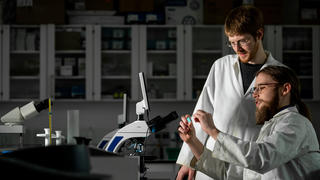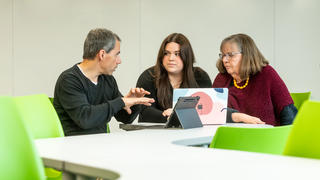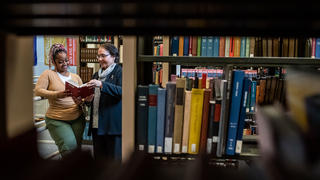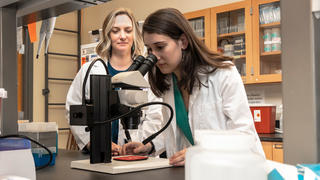Features
The Power of Partnership

Jason Wallach, PhD, assistant professor of pharmaceutical sciences (left), and Garrett Walker ’23, pharmacology and toxicology major (right), examining slides in the lab.
Saint Joseph’s students are driving their own research. They seek out professors to partner with on critical issues that they are passionate about, bringing fresh perspectives and ideas to the table. They gain independence and confidence as they try new approaches, navigating the ups and downs of the research process and, ultimately, coming into their own as scientists, analysts and changemakers.
The research taking place on our campuses knows no boundaries. Students and their faculty research advisors are getting to the root cause of degenerative neurological diseases, using AI to solve issues within our global supply chain, helping probated students overcome systemic oppression, and improving our understanding of synthetic toxins and how they affect brain activity for forensic screenings.
This is how students learn at Saint Joseph’s — working hands-on with guidance from faculty, they go beyond the classroom to turn their ideas into high-impact research that addresses critical challenges of our world.
Strengthening Detection of Recreational Toxins
Research Overview
Having worked together on multiple projects, Garrett Walker ’23 and Jason Wallach, PhD, are currently synthesizing two different PCP-type derivatives to better detect recreational drugs that are being bought and sold as “legal highs.”
“Legal highs” are chemical compounds synthesized in labs that stimulate or depress the central nervous system in a way that mimics the psychoactive effects of illicit drugs, like cocaine or PCP. Recreational chemists tinker with the structure of these compounds so that they will intentionally fall outside international drug controls — at least when they first emerge — but they remain dangerous to consumers, just like the illegal substances they imitate.
“Once we’ve successfully synthesized the derivatives, we’ll have the ability to test how these compounds bind to certain receptors in the brain,” explains Walker. “Ultimately, this research will give us a better picture of how these drugs actually function and how changing the structure of the drug impacts its effect.” Synthesizing these compounds makes it possible for Wallach and Walker to gather analytical data that can be used to detect these drugs in potential forensic or medical research.
On Working Together
Walker has grown exponentially since joining Wallach’s lab — he went from being a first-year student who needed a lot of oversight to someone who checks in with his mentor occasionally to make sure he’s on the right track.
“I feel much more like a scientist,” says Walker. “I never thought I would be this independent in the lab.” Wallach, too, has found growth in his relationship with Walker.
“Garrett is very passionate. I want that in my lab, it’s infectious. Even for me," says Wallach. "It’s so valuable to have someone I can leave in charge of my lab; while I’m teaching or working on grant research, I know he’s there taking care of everything and diving into niche subjects that I’ve always wanted to pursue but have never had the time.”
On Recognizing the Possibilities
“This work I’m doing with Dr. Wallach has completely changed the way I think about how science actually gets done. I used to think only the smartest people were able to work as scientists and that’s just not true,” says Walker.
“It takes some time and effort to learn the language and understand the systems, but just being there and being interested — that’s the main thing. And with the right sense of curiosity and a willingness to work hard, you can really understand it.” “It’s true that people feel intimidated by science and the research we do,” agrees Wallach. “And there is a lot of grit and passion that goes into excelling in this field. It takes effort, sure. But with the right passion and the right dedication, anyone can become a valuable researcher and scientist.”
Using AI to Streamline Our World

Left to right: Marcello Balduccini, PhD, assistant professor of decision and system sciences and director of the Haub Innovation Center; Chasity Nadeau ’20, ’22 (MS), business intelligence; and Jeannine Shantz ’11 (MS), ’22 (MS), business intelligence, meeting in the Haub Innovation Center to discuss their research.
Research Overview
Chasity Nadeau ’20, ’22 (MS) and Jeannine Shantz ’20, ’22 (MS) are working under Marcello Balduccini, PhD, to better understand how cyber-physical systems can be used to reduce the brittleness of supply chains.
A cyber-physical system is a physical device whose behavior is controlled or monitored by computers running dedicated programs. “For instance,” explains Shantz. “Your car. It has a camera on it, right? How is that camera interacting with the environment?”
The camera on an automobile can identify the road in front of or behind it and recognize when a person or vehicle is too close to it — that’s because the computer controlling the car’s camera is taking its physical surroundings into account and incorporating them into the non-physical systems that control it.
Viewing the global supply chain as a large cyber-physical system allows for better management of manufacturing, logistics and shipping.
The team is also working on a handbook chapter on utilizing cyber-physical systems in business contexts.
For example, imagine a mortgage company that can use artificial intelligence to decide how large of a loan to award a person. “Technically speaking, it’s a very complicated process for a machine to understand all your information and assign value to it. Errors can happen quite easily,” says Balduccini. “So this handbook chapter will give companies the answers they need to communicate their process to consumers.”
On Working Together
“Dr. B. really trusts us and encourages us to dive in,” says Nadeau. “Not every research role I’ve taken on has allowed me to be so independent. Jeannine and I really have to figure things out on our own, which has made a big difference in how I approach my professional work. I’m much more confident.”
“When I started working with Dr. B., my entire view expanded,” says Shantz, the director of research, evaluation and assessment at Drexel University’s Close School of Entrepreneurship. “I’m working on projects that are so far beyond the scope of what I started out thinking this degree program was about. It doesn’t seem to matter what academic track you’re on, he’ll find a way for you to contribute in a meaningful way.”
On Accepting the Unknown
I genuinely did not think that this is the type of research I would ever do,” admits Nadeau, who graduated with a major in finance and is working on her master’s in business intelligence. “I’ve always been more geared toward data visualization and analytics. But I’ve really enjoyed the work we do.”
Shantz has been impressed by the level of respect she has received from industry leaders during her work with Balduccini.
“We’re sitting down with the CTO at Intel and a lab director at NIST,” says Shantz. “They’re really open to our thoughts and ideas. They’ve been so gracious and attentive when we’re bringing research to the table. It’s been very affirming.”
Disrupting the School-to-Prison Pipeline

Jaulie Cantave '22, secondary education and English major (left), and Suniti Sharma, PhD, professor and chair of teacher education (right), conducting research in the library.
Research Overview
Suniti Sharma, PhD, began her career as a prison educator and high school English teacher. This intersection of professional experiences — combined with her cultural identity as a woman from India — became her motivation to change how teachers view cultural diversity in a school setting.
“My work lies in guiding my students to become culturally conscious teachers — educators who can engage students who are culturally different from them rather than watch them be shuffled into the school-to-prison pipeline,” says the Saint Joseph’s professor, who prepares her students to teach high school English and history.
That’s where Jaulie Cantave ’22 comes in. In the summer of 2021, Cantave began working under Sharma through Saint Joseph’s Summer Scholars program — a program in which undergraduates participate in faculty-mentored research and other scholarly endeavors. With Sharma as her research advisor, Cantave expanded upon Sharma’s work to disrupt the school-to-prison pipeline, working with high-risk youth at The Academy in Norristown. The school-to-prison pipeline is defined by the ACLU as a “disturbing national trend wherein children are funneled out of public schools and into the juvenile and criminal justice systems.”
Students land in the school-to-prison pipeline for a complex set of reasons, including cultural alienation from schools or misuse of the zero-tolerance policy to criminalize students who are culturally different, come from economically depressed neighborhoods, or who have learning disabilities but no access to support. Students of color are especially vulnerable to these trends and the discriminatory application of discipline.
The Academy is an academic day program for young men who have demonstrated disruptive behavior in a school setting and been pushed out to a nontraditional program. Cantave is tracking how an increased level of literary enrichment supports these students’ current school experiences and enables their transition back to a more traditional academic environment.
Cantave is also mentoring these young men and discovering what tactics are most effective in forging deeper connections between educators and students who have been labeled at-risk.
"Jaulie’s research will be used by future teachers in our teacher preparation — her findings will connect them with the cultural knowledge, testimonials and actual experiences of students labeled at-risk,” explains Sharma. “The goal is to generate knowledge useful to teachers who are teaching cross-culturally, making equity a priority and inclusion the starting point of teaching and learning.”
On Working Together
For Sharma, research and teaching have a symbiotic relationship.
“In Indian culture, the ‘guru-shishya parampara’ translates into ‘the teacher-scholar tradition’ and is key to students’ and teachers’ professional and spiritual development,” says Sharma. “It affects every aspect of life including teaching and learning. So to have the opportunity to work with students while immersing ourselves in a research project is its own reward.”
Cantave, who is in the process of becoming a general education teacher herself, has been able to dive more deeply into her values as an educator under Sharma’s wing.
“It isn’t always enough to be a good person,” says Cantave. “That isn’t what will make you a good teacher. You need to use research to stay active and up to date. That’s what shows you care.”
On Overcoming Challenges
“This work is so humbling,” says Cantave. “I am a Black, gay person from Philadelphia, so understanding the prison industrial complex is important to my personal life as well as my professional one. My students are crazy intelligent and very capable, but undoing the effects of systemic oppression can feel impossible.”
Despite the enormity of the task at hand, Sharma remains impressed by her student’s determination.
“Jaulie has been able to go beyond her own struggle with this subject to really connect with students at The Academy,” says Sharma. “She continues to integrate the knowledge generated from her research into what she’s teaching.” Cantave knows that staying current and available is critical to her success.
“Kids, especially kids in Philadelphia, need teachers who are hyper aware of the society in which they live,” Cantave says. “It all impacts the classroom and how our kids will be able to learn and grow.”
Getting to the Root Cause of Alzheimer's

Margaret Panning Pearce, PhD, associate professor of biology and neuroscience (left), and Jenna Hunt '23, neuroscience major (right), reviewing samples.
Research Overview
Jenna Hunt ’23 and Margaret Panning Pearce, PhD, are conducting research on neurodegenerative diseases, working with a microtubule-associate protein called "tau" for short, which is implicated in Alzheimer’s disease. Hunt is trying to model Alzheimer’s disease in Drosophila, or fruit flies, in an attempt to see the expression of the tau protein in the brain. Once the model works, Hunt will be able to learn more about what might cause Alzheimer’s disease.
“I developed this research model to study how these protein assemblies form in the brains of patients with neurodegenerative disorders like Huntington’s and Alzheimer’s diseases,” explains Pearce. “The one that Jenna has focused on is an inherited tauopathy, [diseases caused by misfolding of the tau protein], known as frontotemporal dementia.”
As Pearce established her own lab as a professor, her work in better understanding how these protein aggregates could spread through the brain came to the forefront of her research.
“The hypothesis we focus on in my lab with students like Jenna is that different cell types participate in a different way in a brain experiencing neurodegeneration,” says Pearce. “And that’s groundbreaking. It’s not just neurons — it’s these non-neuronal cells, known as glia, that seem to play a major role in the development and progression of these diseases. So the major questions we’re asking are, how is this happening? And could the molecules and pathways we identify become viable drug targets in the future?”
On Working Together
“Dr. Pearce is kind of my guiding light for everything research and career-oriented,” says Hunt. “All that she’s accomplished — having a lab and a family and outside interests — it’s everything I want for myself.”
Originally, Hunt had intended to go to medical school after getting her degree in neuroscience. Since joining the Pearce lab, however, Hunt’s appreciation for research has grown exponentially.
“I’ve always been very impressed by Jenna,” says Pearce. “Not many first-year students have time to pursue research, and she was asking about joining my lab as early as her orientation week.”
The pair has now been working together for three years. “Frankly, I feel a little spoiled to have Jenna in my lab,” admits Pearce. “She has such a strong passion for research and science — and such unique intelligence. She even works with me over winter and summer breaks!”
On Accepting the Unknown
So far, Hunt has come up against one very significant issue in this research: The model has yet to produce the expected results, which means she and Pearce must continue exploring alternative approaches to observe the spreading of tau proteins in the Drosophila.
Learning how to fail has been the most humbling lesson of all.
But that’s the thing about science, she says. Research lies in being able to accept the unknown of it all and pivot to other experimental approaches.
“Relinquishing control to the cells and the science is really hard, but really exciting,” she says. “Accepting that I might fail has been the hardest thing I’ll ever do, but it’s also where I’ve made the most progress.”